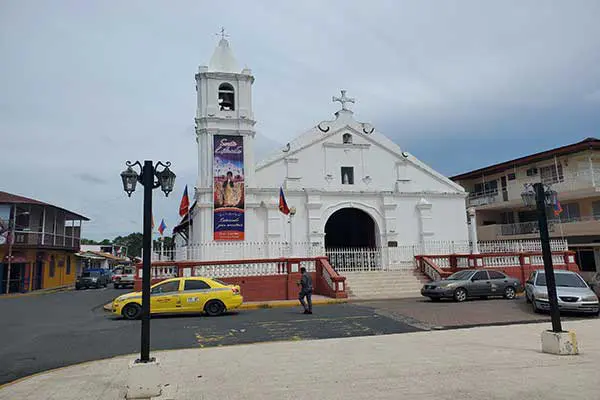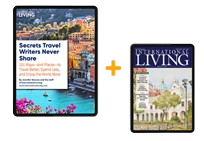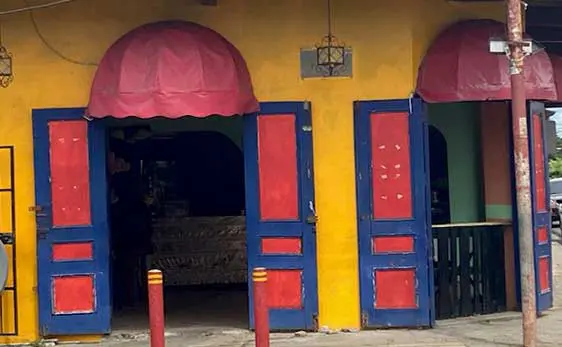Las Tablas, Panama
By Gabriele Walkow
Nestled in the rolling ranchlands of Panama’s Azuero Peninsula, four hours driving time from Panama City, Las Tablas is a charming, welcoming, and picturesque town. Meandering through fertile farmlands, grazing cattle, and sweeping hills, the highway leading into Las Tablas sets the stage for this largely agricultural community.
Home to a lively town center, a friendly local population, and a culturally rich heritage, the capital of Los Santos province is one of the best places in Panama to live a stress-free, relaxed, and affordable retirement.
In addition, Las Tablas is located in a region known as the “Arco Seco” (Dry Arc) and enjoys some of the best year-round weather in Panama, during both the dry season (December to April) and the wet season (May to November).
Brimming with local charm, Las Tablas is also home to a host of professional services and amenities. And with the larger center of Chitre only 30 minutes away, expats can find everything they need.
Retire in Las Tablas, Panama

Located a few miles inland from the Gulf of Panama, approximately 10,000 to 12,000 people call Las Tablas home. This includes about 125 expats living in the town and its five principal beaches. (There is a larger expat community in nearby Pedasi, 30 minutes away.)
This area typically appeals to people who prefer a simpler, more traditional lifestyle, which includes fully integrating into the local community.
Friends and family, especially the elderly, are highly valued here and there is great respect for culture, customs, traditions, and folklore. Although more people are speaking English these days, most signs and menus are in Spanish only, so learning the language and/or using a translation app is highly recommended.
Las Tablas is home to three hospitals, several labs, dentists, and some other healthcare professionals. Dental cleanings run about $30 and extractions are $50. Larger hospitals and clinics, and a bigger roster of medical professionals, can be found in Chitre.
Several excellent restaurants include Dolce & Saladito with a great lunch menu for $5 and a delicious regular menu with veal parmigiana, hamburgers, and chicken. La Hacienda, with a spectacular evening view, has more exotic flavors, such as mango-seasoned pork chops, chicken breast in a white coconut sauce, and beef in a passion fruit sauce. Casa 21 is known for the best pizza around and delivers as well. All feature fabulous fare and friendly, helpful staff.
For those seeking a fast-food fix, Las Tablas is home to a McDonald’s, Domino’s Pizza, and the recently opened and very affordable Pio Pio, which offers a varied menu of fried chicken and traditional Panamanian food.
Fondas (small, simple restaurants) are plentiful, very affordable, and popular with locals and expats alike for their savory traditional Panamanian food.
Both Super Carnes and Super Rosa offer a good selection of American and Panamanian groceries, including fresh meat, at low prices. Local vendors sell fruit, vegetables, and fresh seafood from their trucks near the entrances to both stores.
A new addition to the shopping scene in Las Tablas is the American-style one-stop-shop Super Xtra Market, where you can find everything from meat to seafood, a delicatessen, home and hardware items, and a pharmacy. In Chitre, there are additional larger supermarkets and home and hardware stores as well.
Bring your own reusable shopping bags as Panama has a plastic bag ban. And depending on where you live in Las Tablas, you don’t necessarily need a car as taxis are plentiful and inexpensive. And they are always parked nearby to take you home with your groceries.
Lifestyle in Las Tablas, Panama

Avenida Belisario Porras is a bustling and colorful street running through the heart of town and takes you to the central plaza known as Parque Belisario Porras. Join the locals in Parque Belisario Porras to people-watch and get a sense of everyday life in a busy, conventional Azuero Peninsula town. Young and old gather under the trees and on the benches filling the air with laughter and chatter. With colorful hammocks, food vendors, and tiendas (stores) all around, this is the pulse of the town.
Visit the Baroque-style church, Iglesia Santa Librada, which stands on the corner of the park. Although much of the church was destroyed in a fire in 1958 and later restored, the church itself dates back to 1789.
Opposite the central plaza, delve into Panamanian history at the Museo Belisario Porras. Belisario Porras’ administration was in power during the construction of the Panama Canal. The museum is set in his former home and contains small artifacts and memorabilia from his life.
One of the main attractions of Las Tablas is its authentic culture, and people here take to the streets to celebrate with many annual festivals.
During the vibrant Festival Nacional de la Pollera, held in July, hundreds of women wear elaborate handmade polleras, Panama’s intricate national dress, and dance in the streets to festive Panamanian music. A single pollera can take months to make and may be passed down from generation to generation—and they are a sight to behold.
Carnaval, however, is Las Tablas’ biggest annual celebration. Thousands of locals, expats, and visitors from other Panama provinces, Panama City, and overseas fill the streets to see the ornate carnival queens, elaborate parade floats, fireworks, and marching bands, as well as to experience the non-stop dancing, music, and an abundance of food and drinks. Large water trucks that spray the partygoers provide welcome relief from the heat of the day! This multi-generational family affair, held over five days in February, is the most anticipated event of the year.
The area is centrally located for visiting several Azuero Peninsula gems. For a memorable day trip, travel the scenic road over the mountains to Tonosi, which then leads to the remote and beautiful beaches of Cambutal. And in Pedasi, a 20-minute boat ride from Playa el Arenal takes you to the gorgeous Isla Iguana Wildlife Refuge. This is an idyllic destination for swimming, snorkeling, and scuba diving in the warm, turquoise waters. Playa Venao, Panama’s bohemian surfing mecca, is another 35 minutes from Pedasi.
Cost of Living in Las Tablas, Panama

Generally, the cost of living in Las Tablas is lower than other places in Panama.
Monthly Budget Breakdown for a Couple in Las Tablas, Panama:
| Expense | U.S. $ |
| Rent (three-bedroom apartment in town) | $450 to $800 |
| Rent (on the beach) | $650 to $1000 |
| Electricity | $35 to $125 depending on A/C use |
| Water | $6 (usually included with the rent) |
| Gas | $5 per month |
| Cell phone (x2) | $30 per month |
| Internet | $35 in town/$65 at the beach |
| Transport (taxis, buses) | $20 |
| Groceries and household items | $400 |
| Dining out (eight meals per month) | $80 to $140 drinks included |
| Total expense in town: | $1,090 to $1,590 |
| Total expense on the beach: | $1,320 to $1,820 |
The Takeaway
Las Tablas is one of the safest and most affordable towns in Panama. If traditional living with amenities nearby by, a supportive, local community, and year-round warm weather are calling your name, then Las Tablas should be on your radar.

Get Your Free Panama Report Here:
Learn more about Panama and other countries in our daily postcard e-letter. Simply enter your email address below and we'll send you a FREE REPORT — Panama: Easy, First-World Living and the World's Best Retiree Program.
This special guide covers insider advice on real estate, retirement and more in Panama. It's yours free when you sign up for our IL postcards below.
Retire in Las Tablas, Panama for $1,000 a Month
by Jessica Ramesch
Located on Panama’s Pacific coast, little Las Tablas is Panama at its best. This town of under 30,000 people lies on the Azuero Peninsula, a region renowned for everything from colorful Carnival celebrations to artisanal textiles, pottery, and leatherwork. Life in this region of Panama is good.
It is graced with more sunny days and less humidity than any other part of the country. And the cost of living is the lowest in Panama: Here, a couple can easily live on $1,000 a month, including rent, as expats Joyclyn and Armand Brodeur have found out.
Originally from St. Louis, the Brodeurs came to Las Tablas in August 2014 to test-drive their Panama retirement, so to speak. Armand, 66, and Joyclyn, 59, long yearned for a tropical, beach lifestyle. At the same time, they wanted to choose a place where it was possible to live on a Social Security check. “Las Tablas fits the bill,” they say, citing the excellent infrastructure and affordable healthcare.
The Brodeurs chose Las Tablas so they could live well, without sacrificing the good things in life. They were amazed at the local supermarket prices…$0.55 for a beer and $4 for a bottle of wine. Armand says, “I treat myself to Clan MacGregor scotch at $9 a bottle, about the same as up north. Bacon is about $4 a pound, but it costs even more in St. Louis.” Even so, they spend just $65 a week on groceries.
Utilities are also extremely inexpensive. Their first power bill was around $20 (no air conditioning). “Our water is included in our rent, and trash pickup is $18 a year,” they say. Vonage internet phone service is $32 a month and allows for toll-free calls to the U.S. and other countries. Add to that another $30 to $40 a month for two cellphones (calls plus data) and $52 for bundled cable and internet.
The Brodeurs are most enthusiastic about the quality and affordability of the healthcare, however. Both have been to a local dentist and were impressed with the offices, equipment, and thorough manner. “She’s the best dentist I ever had,” says Joyclyn. “Armand went in for a broken tooth and paid just $15.”
“I thought I heard wrong,” he says. “She spent an hour and a half on me; it was like a minor surgery. And there was no pain. They are not stingy with the Novocain down here.”
With more money in their pockets and no shortage of time on their hands, the two have been able to fully immerse themselves into the local way of life. At a recent festival in rural Panama, Joyclyn and Armand had one of their first brushes with Panama’s colorful culture. “I saw a bull run, and it was fascinating,” says Joyclyn. There were oxcarts painted in bright primary colors, local boys in traditional garb, and girls in richly embroidered polleras—Panama’s much-admired national costume.
“They would pose and display their dresses,” she says. “It was the best party I had ever seen. I even danced with an older local man. The music was playing and he was twirling me around,” she says, smiling at the memory.
The people of Panama are another major plus for the Brodeurs. “The neighbors are very friendly and we are inundated regularly with gifts of wonderful Panamanian food,” says Armand.
When they’re not dancing and socializing, you can often find Armand and Joyclyn enjoying their home in Las Tablas. “The day starts with Panamanian coffee—usually on the front porch. We have a papaya tree in the backyard and have fresh papaya regularly for breakfast,” says Armand. It’s a simple, effortless lifestyle… though the nearby beaches do make it sound a bit glamorous.
In the Pedasí region, about 45 minutes away by car, are some of Panama’s most pristine stretches of sand. And the fishing is legendary. But the ocean-loving Brodeurs don’t have to go far to get their fix. The craggy shores of Uverito beach are mere minutes from the Las Tablas town square.
“Our anniversary was in December, and we spent it at Uverito,” say the Brodeurs. Christmas Day and New Year’s Day found them back again, enjoying the beach alongside many locals. “We lament to friends on Facebook about the grueling 11-minute drive to the beach,” Armand jokes.
Trips to Uverito aside, the Brodeurs do most of their traveling by foot, as many of the locals do. And all the walking has had an unintended effect. “We have dropped an incredible amount of weight,” says Armand. “And we’re not even eating as healthy as we ought to.” Joyclyn says walking is also the best way to get the lay of the land. “I know where to go for a lot of things now…and with the hot weather, we don’t eat as much. I’ve dropped a whole size,” she adds.
Las Tablas is a far cry from Panama City. You’ll find no skyscrapers here…in fact, structures more than two stories tall are rare. Condo living is more of an abstract concept here, as people tend to live in boxy, wide-terraced homes. In most cases, they are framed by greenery that runs right up to the road. Here and there is a casa de quincha, a country cottage made the old-fashioned, wattle-and-daub way, with clay and straw.
The town plaza is graced by a small, white, colonial church. Like most of Las Tablas, it is unassuming, though visitors who enter are met with the soft glow of the ornate gold altar, a relic from Panama’s earliest colonial days.
A short walk from the main plaza, the Brodeurs have rented a small home for $200 a month. They paid $600 for a slightly upscale apartment during their first month in Las Tablas. It was ready to move into and in a central location, so it worked while they were getting settled. Soon, however, they were ready to try a local-style home. They just did a bit of networking—and used the few words of Spanish they’ve learned since their arrival. It paid off. An expat introduced them to a local homeowner and the next thing they knew, they were signing a new rental agreement.
These days, the Brodeurs say they have many more friends— both Panamanian and expat—than they did “back up north.” Life is more social and more fun. As Las Tablas is at the nation’s center, they can travel anywhere with ease. They recently visited Panama City—it’s about four hours by car due east. The western province of Chiriquí is similarly close, so they’re planning a trip to the highland towns of Boquete and Volcán Barú in the near future.
Will the Brodeurs stay in Las Tablas? Who knows—they are still exploring the country, and they’re keeping an open mind. A few months into their “test-drive,” however, they’re already quite certain that Panama is right for them. “I wanted access to the ocean, friendly people, and palms…and I got it all,” says Joyclyn. “It would not break our hearts to live in Las Tablas for the balance of our days,” says Armand.
Featured Image Copyright: ©Gabriele Walkow



